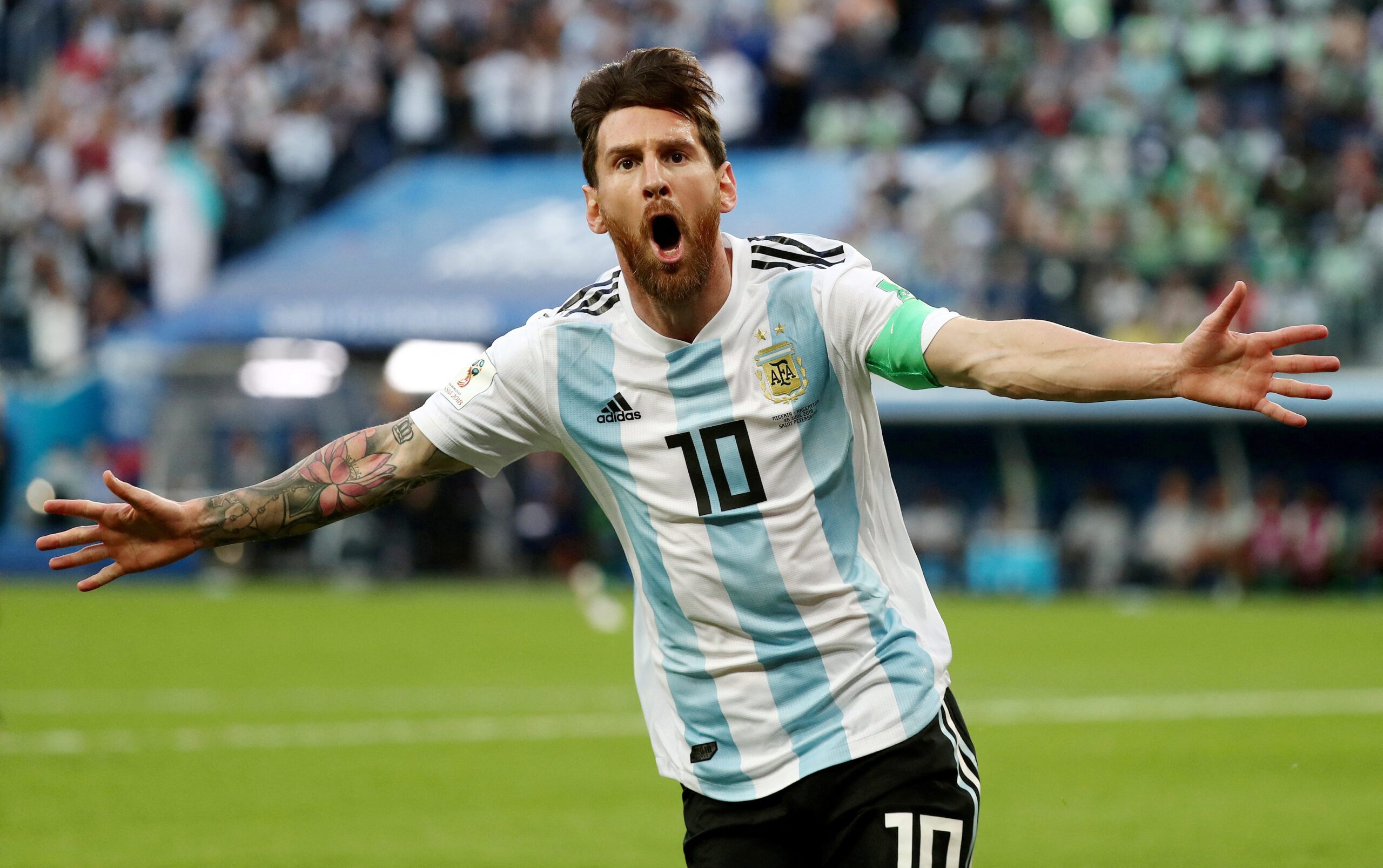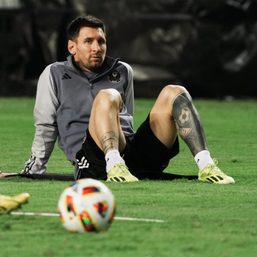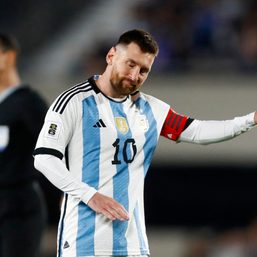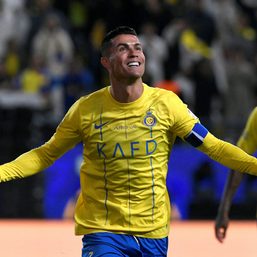SUMMARY
This is AI generated summarization, which may have errors. For context, always refer to the full article.

This is Part 3 of Rappler’s World Cup 2022 series.
- Part 1: Group of Underdogs
- Part 2: Group of War
Group C – Argentina, Mexico, Poland, Saudi Arabia
The international border that separates Mexico and the United States is the 10th longest in the world. Spanning over 3,000 kilometers, it extends from the Gulf of Mexico on the eastern end, following the winding Rio Grande river across Tamaulipas, Nuevo Leon, Coahuila, and Chihuahua on its southern bank and Texas to its north. From the cities of Ciudad Juarez and El Paso, the border continues towards the Pacific Ocean flanked by Sonora and Baja California on the Mexican side and the US states of New Mexico, Arizona, and California. It is the most frequently crossed international border in the world, with over 350 million crossings documented annually.
For centuries, this exchange of commerce and labor has contributed immeasurably to the economy on both sides and has created a unique border culture and social hierarchy. The border area offers some of the most breathtaking topography in the hemisphere, documented in films such as Gregory Nava’s classic El Norte, and North of Ojinaga by Austin-based Filipino director Rommel Eclarinal.
What the figure 350 million does not include are the countless migrants who cross into the United States clandestinely to avoid documentation and the labyrinthine immigration process for which many have no resources to pursue, in search of greener pastures and a safe haven from the desperate conditions of poverty and persecution, in the hopes that they are able to provide for their families back home and establish a more hopeful future for them and themselves.
Forced into situations in which options, if any, are severely limited and difficult, many choose to brave the treacherous journey north in search of work and a better life – the same reasons why countless Europeans risked everything including their lives to cross an entire ocean for the New World. For those who have no choice but to take the undocumented path northwards, the alluring landscape becomes a beautiful hell, one of the most dangerous border crossings in the world over unforgiving desert terrain, replete with bandits and vigilantes on both sides of the border. Many do not survive this crossing.
While migrants crossing the Mexico-US border hail from a variety of countries in Latin America as well as some from Asia and Africa, an overwhelming majority are Mexican nationals. Whether documented or not, these Mexican migrants form a critical component in the most powerful economy in the world, providing labor in every sector, including agriculture, industry, culinary production, music, art, education, public service, literature, child care, medicine, construction, academics, sciences, healthcare.
Contrary to the racist stereotypes portraying them as sombrero-clad siesta-takers, or criminal drug-smuggling gang members as some recent white American politicians like to insinuate, migrants from Mexico are among the hardest-working people in the world.
In my 23 years serving underprivileged recent immigrant communities in southeast Texas public sector middle schools as an educator and soccer coach, I have yet to come across a student, player, parent, colleague, employee, neighbor, or friend of Mexican nationality who even remotely fits that false racist caricature. Every Mexican or Mexican-American person I have ever encountered is an extremely hard worker dedicated to their family, their ambitions and dreams, persevering through whatever hardship society has placed before them.
It is no wonder to me then, that whenever I watch the Mexican national team play in any competition – whether World Cup qualifiers and finals, Gold Cup, Olympics, or friendlies – they are hands-down, er feet-down, the hardest working team out there. This kind of work ethic lends itself perfectly to the strategic decision to which the Mexican playing style is committed. Offensively, this means continuous and fluid movement of the ball, requiring all players in the park to be in constant motion and creative mode, the ball finding its way through gaps in opposing defenses.
The hallmark of Mexico’s strategy however is most evident in their defensive commitment – constant and immediate pressure starting up high, taking away opposing space on the ball and not allowing the opposition to establish a rhythm. This is a commitment that every player has made in every third of the field. It takes a tremendous amount of hard work. In this aspect, Mexico has taken the Total Football approach to its furthest application. It is a thing of beauty to behold.
This Mexican work ethic encompasses all players on the pitch, including the man in the frame. Memo Ochoa has done well in continuing Mexico’s legacy of excellence in the goalkeeper position. Ochoa is the latest in a lineage of legendary Mexican goalkeepers going back to Antonio Carbajal, who played in five World Cup tournaments from 1950 to 1966, equaled among keepers only by Italy’s Gianluigi Buffon. Carbajal was named by the International Federation of Football History and Statistics as the top goalie in the history of the North American confederation.
Known for his colorful on-pitch kit and spectacular playing style, Jorge Campos was Mexico’s No. 1 keeper throughout the 1990s, representing the nation in two World Cup tournaments. In 1993, Campos was declared the third best goalkeeper in the world by IFFHS. In a career spanning 26 years in the Mexican top flight, Conejo Perez holds the record for most league matches played with 740. He won the 1999 FIFA Confederations Cup with Mexico, defeating Brazil in the final, and then going on to represent his country in the 2002 and 2010 World Cups.
El Tri’s goalkeeper in the 2006 big dance Oswaldo Sanchez has won the Golden Glove award on 10 different instances during league and international play. For seven straight World Cup cycles since 1994, Mexico has made it into the knockout rounds with Campos, Perez, Sanchez, and Ochoa in goal.
Now playing in his third successive World Cup, Memo Ochoa has already written his name in the book of legendary keepers. In the 2014 edition, in a group with heavyweights Brazil, Cameroon and Croatia, Ochoa registered two shutouts, including of Brazil, and conceded only one goal as Mexico swept the group.
His knack for making seemingly impossible saves would continue into 2018 in Russia. Perhaps the most definitive match of Ochoa’s career was Mexico’s opener against Germany, in which he made a total of nine saves to shut down the relentless offensive machine of the defending champions. In four total matches, Ochoa logged 25 saves for el Tri, bested only by Belgium’s Courtois with 27 in seven games.
At 37 years old and 130 caps, we may be seeing Memo Ochoa for the last time in a World Cup box. In order to extend Mexico’s knockout rounds streak, Ochoa will have to play the best goalkeeping of his fabled career considering the legendary strikers he will be facing in Group C.
On November 23, Poland’s Robert Lewandowski will be the first to test Ochoa’s resolve. Since starting his pro club career in 2004, Lewandowski has accumulated a mind-blowing 560 goals in 766 matches with seven different clubs. He tallied 344 of those during eight seasons with Bayern Munich where he won the Bundesliga title every single year he was there. Prior to his move to Munich, he hit the net 103 times in 187 games on his way to two league titles with Borussia Dortmund.
It doesn’t look like he has slowed with age. At 34 years old, Lewandowski has moved to Barcelona and has already racked up 18 goals in 13 outings this season, including three in a Champions League trouncing of Viktoria Plzeň, becoming the first player in the competition’s history to score a hat trick with three different clubs. He has won the European Champions League, the Club World Cup, the domestic championship of two different countries and now looks to be on track for a third.
Considered one of the greatest strikers of all time, Lewandowski’s list of individual awards goes on forever. Even off the pitch, he is a champion for numerous charitable causes. In 2014 during his first season with Bayern, UNICEF named Lewandowski a Goodwill Ambassador.
Conspicuously missing from Lewandowski’s long inventory of achievements is anything pertaining to the World Cup. In 2018, his only World Cup campaign thus far, he was held goalless and Poland crashed out in the group stage. At the zenith of his career, 2022 may very well be Lewandowski’s final crack at making his mark on the world’s most important tournament. The most capped player in Polish history, Lewandowski holds the record for most national team goals at 76.
However, no one else in the national team pool even comes close in both goals and experience. Lewandowski remains Poland’s lone consistent offensive threat. To get past a goalkeeper like Memo Ochoa, guys like Napoli’s Piotr Zieliński and Andriusz Milik of Juventus will have to step up and play the game of their lives. Without effective support, Lewandowski will find himself struggling to find the net again.
Since Mario Kempes scored six goals in the 1978 World Cup, including two in the final that sank Holland, a decade has not elapsed without an iconic Argentine striker in the world. After Kempes’ reign, perhaps the most iconic striker in history Diego Maradona captained the Argentine side to win the 1986 tournament, captivating the world with a dynamic and exciting playing style.
The second-best player ever (the best according to some), Maradona passed the torch on to Gabriel Batistuta, who established himself as a premier striker when he finished as top goal-scorer in the 1991 Copa America, Argentina’s 13th continental championship. A statue of Batistuta stands in Florence where the prolific goal-scorer shot Fiorentina to Serie A glory. You can’t get any more iconic than that.
Batistuta held the Argentine national team record for most career international goals until it was surpassed by this generation’s most iconic striker. A legend in his own time, Lionel Messi became the third Argentine player to score in three different World Cup tournaments, after Maradona and Batistuta. There are not enough superlatives in my vocabulary to describe Messi’s accomplishments on the field, including a lengthy catalogue of titles, records, milestones, and championships.
Filipinos also know Messi as the player who broke Paulino Alcantara’s career goals record at Barcelona. The greatest player to emerge from the Philippines, Alcantara was born in Iloilo province and moved to Spain as a young child with his parents. In 1911, he debuted for FC Barcelona’s senior side at the age of 15, scoring three goals in his first match.
By the time he retired in 1927, Alcantara had tallied 395 goals in 399 matches forever engraving his name among football legends in Spain and in the country of his birth, both of whom he represented internationally. Alcantara’s record stood for almost a century, quite a remarkable feat, especially seeing the names that graced Barcelona’s roster after him, such as Maradona, Cruyff, Ronaldinho, Ronaldo, Eto’o, Iniesta, and so on. It took no less than a Lionel Messi to break Alcantara’s record in 2014.
Off the field, Messi is a champion in social advocacy. He has been a UNICEF Goodwill Ambassador since 2010, traveling to calamity-stricken places like Haiti after the earthquake of that year, and advocating for the rights of disabled children. Through the Leo Messi Foundation which he established in 2007, he has worked for children’s access to education, health care, and sports, financing research and investing in medical facilities around the world.
Despite Messi’s innumerable club accomplishments, international glory has eluded him. Until he finally attained his first Copa America championship in 2021 at the age of 34, Argentina finished in second place three times with him on point. In Brazil 2014, Argentina fell to Germany in Messi’s one and only World Cup final to date.
One of the undisputed favorites to take the trophy back to South America after four straight European conquests, Messi will be leading a determined and unstoppable Argentine attack in the fifth campaign of his illustrious career.
Now 35 years old, Qatar may or may not be his last. In a high-profile transfer to Paris Saint-Germain last season, he has proven that he is still at the top of his game, helping the club finish his first season there as Ligue 1 champions. With Argentina, Messi has a stellar and experienced cast around him who can deliver the ball, or finish one of his spectacular assists. With high-quality support like Juventus’s Angel Di Maria and Roma’s Paulo Dybala, Messi will be leading a juggernaut offense against which Ochoa will have to produce another career-defining game to keep Mexico in it.
Group B features a tripartite duel between two of the greatest strikers and one of the greatest goalkeepers of our time.
Growing up in a diplomatic family, I personally experienced the power of football to transcend human barriers – linguistic, cultural, religious, political, social, economic… My first encounter with the game was in Beijing, China, when my father was posted there as Charge d’Affaires of the newly opened Philippine embassy in the mid-1970s.
Just about everyday after coming home from school, I would go outside to join other kids from different countries in French-speaking Africa, who would spend endless hours playing football in the parking lot of our residential compound reserved exclusively for diplomatic families. These are the kids who taught me how to play the game. It didn’t matter what social systems prevailed in our respective countries, nor our religious and cultural backgrounds, the color of our skin, economic statuses, stances of our governments on issues. We couldn’t even speak the same language. But we could all play the same game.
In 2017, the Saudi Arabian government severed diplomatic ties with Qatar, accusing its neighbor of supporting terrorist groups in the region. Joined by several other members of the Gulf Cooperation Council, such as the United Arab Emirates, Bahrain, Yemen, and Egypt, Saudi Arabia blockaded Qatar and even threatened invasion. Efforts to mediate by Kuwaiti and American diplomats paid off and the blockade was lifted early last year. While relations between Qatar and its neighbors have been restored, analysts agree the fundamental conflict that caused the rift has yet to be resolved.
Throughout this entire episode of geopolitical instability, one thing that could not get blockaded was football. In the midst of their embargo, Bahrain, UAE, Yemen, and Saudi Arabia sent their national teams to contest the 2019 Arabian Gulf Cup hosted by Qatar, and the Asian World Cup Qualifying competition continued without a hitch.
I like to think that the World Cup being hosted in the Middle East for the first time contributed to the rapprochement, pressuring the countries to get over their squabbling just in time to not spoil the biggest party in the world. I’m pretty sure the Saudis also did not want their fans blockaded from the host country, at least until early December, including women, who until 2018 the kingdom barred from spectating at football matches. (How FIFA allowed Saudi Arabia to get away with that travesty for over half a century is another question for Infantino.)
With the borders open again, November 22, 26, and 30 are now looking like home matches for the Green Falcons. They’re going to need all the support they can get. The Saudis may have ended one blockade, but they are about to face another, one they will surely not get through, with or without home desert advantage.
From 1994 to 2006, Saudi Arabia had a run of four consecutive World Cup qualifications, led by legendary goalkeeper Mohamed Al-Deayea, the most-capped goalkeeper in the history of the game, and Sami Al-Jaber, the country’s second all-time leading scorer. But these two belong to a past era. Since their first qualification in the USA in 1994 when they surprised Morocco and upset Belgium to hurdle into the round of 16, the Saudis have posted some embarrassingly atrocious results.
The last time the big dance was held in Asia, at Korea/Japan 2002, they produced their worst showing, losing all three of their group matches with zero goals scored and conceding 12. This ranks as the worst World Cup performance by a single team in the 21st century.
Cumulatively, out of the 12 matches played in their last four finals tournaments, the Saudis won one, drew two and lost the rest piling up a -27 goal differential. As representatives of the Asian Football Confederation, of which my country is a member, it’s hard to swallow that Saudi Arabia went into the 1998 edition as reigning Asian Cup champions and 2002 as the continental runners-up. In Russia 2018, they opened the tournament with a 0-5 annihilation by the hosts. I’m looking for better representation, but by the looks of Group C, the Green Falcons are once again in over their heads in 2022.
There’s really nowhere to go but up for head coach Hervé Renard. Appointed in 2019, Renard has produced some hopeful results, finishing at top of their Asian qualifying group. With a European coach’s mindset for development, he is no doubt wishing that the Saudi Arabian Football Federation, like the government’s policy towards women spectators, would finally relax the practice of barring their players from signing contracts abroad.
Players such as midfielder Fahad Al-Muwallad of Al-Shabab and Al-Hilal forward Saleh Al-Shehri could have reached new frontiers for the Saudi program if only allowed to gain invaluable experience competing in the world’s top leagues. At 28 and 29 years old respectively, Al-Muwallad and Al-Shehri are just about at the peak of their careers now. It may be a little late for them, but certainly not for the next generation. Striker Firas Al-Buraikan is only 22 years old and has already been capped 26 times, netting six for the national team. Al-Buraikan represents the future of the Saudi program.
If the Saudis are to progress, they will have to get their players out into the best leagues in the world and globalize their game. They need to stop controlling their national players like a fossil fuel commodity. Footballers don’t devalue when they are released into the market; the inverse of that usually happens. Until then, the Green Falcons will forever be lacking that legendary player to lead them out of exile in the bottom desert and return to the oasis of the knockout rounds.
Group C standings prediction
- Argentina
- Mexico
- Poland
- Saudi Arabia
(Next: Part 4 – The Group of Life after Death)
– Rappler.com
Kokoy Severino is a career educator and nationally certified youth soccer coach in the United States who now lives in his home country of the Philippines. For over 23 years, he implemented the beautiful game as a gang-intervention program in high-poverty urban school districts in the Greater Houston area of Texas. He has also worked with economically-disadvantaged communities in the Philippines, using football to mentor youths out of poverty. He is on the coaching staff of the Football for Peace movement, the Elmer Lacknet Bedia Football Academy, and a core member of Initiatives and Hearts for Indigenous People, a collective of volunteer soccer coaches who work with youths in poverty, particularly among the marginalized ethnic minorities of the Philippines.
Add a comment
How does this make you feel?









There are no comments yet. Add your comment to start the conversation.